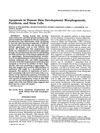Desmosomes in Developing Human Epidermis
January 2010
in “
Dermatology Research and Practice
”
TLDR Desmosomes are crucial for human skin development, increasing in density as the skin matures.
This review examined the development of human epidermis, emphasizing the role of desmosomes in cell differentiation and tissue morphogenesis. Desmosomes were identified early in fetal development, with their density increasing as the epidermis matured, forming multiple layers by 21-24 weeks of embryonic gestational age (EGA). The study highlighted differences between human and murine epidermal development, noting genetic variations and the presence of desmosomal proteins. It observed that desmosomal protein density increased over time, with significant changes in keratin expression and desmosomal protein distribution by 21 weeks, resembling mature epidermis. The study also discussed the importance of Wnt/β catenin signaling, calcium in desmosome assembly, and the epidermal growth factor (EGF) family in skin proliferation and differentiation. The document concluded that more human-specific studies were needed to better understand skin development and its pathological conditions.

